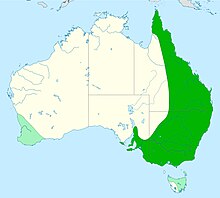Laughing kookaburra
| Laughing kookaburra | |
|---|---|
 |
|
| Scientific classification | |
| Kingdom: | Animalia |
| Phylum: | Chordata |
| Class: | Aves |
| Order: | Coraciiformes |
| Family: | Alcedinidae |
| Subfamily: | Halcyoninae |
| Genus: | Dacelo |
| Species: | D. novaeguineae |
| Binomial name | |
|
Dacelo novaeguineae (Hermann, 1783) |
|
 |
|
| Distribution within Australia | |
| Synonyms | |
|
|
The laughing kookaburra (Dacelo novaeguineae) is a carnivorous bird in the kingfisher subfamily Halcyoninae. Native to eastern mainland Australia, it has also been introduced to parts of New Zealand, Tasmania, and Western Australia. Male and female adults are similar in plumage, which is predominantly brown and white. A common and familiar bird, this species of kookaburra is well known for its laughing call.
The laughing kookaburra was first described and illustrated (in black and white) by the French naturalist and explorer Pierre Sonnerat in his Voyage à la nouvelle Guinée which was published in 1776. He claimed to have seen the bird in New Guinea. In fact Sonnerat never visited New Guinea and the laughing kookaburra does not occur there. He probably obtained a preserved specimen from one of the naturalists who accompanied Captain James Cook to the east coast of Australia.Edme-Louis Daubenton and François-Nicolas Martinet included a coloured plate of the laughing kookaburra based on Sonnerat's specimen in their Planches enluminées d'histoire naturelle. The plate has the legend in French "Martin-pecheur, de la Nouvelle Guinée" (Kingfisher from New Guinea).
In 1783 the French naturalist Johann Hermann provided a formal description of the species based the coloured plate by Daubenton and Martinet. He gave it the scientific name Alcedo novæ Guineæ. The current genus Dacelo was introduced in 1815 by the English zoologist William Elford Leach, and is an anagram of Alcedo, the Latin word for a kingfisher. The specific name novaeguineae combines the Latin novus for new with Guinea, based on the erroneous belief that the specimen had originated from New Guinea. For many years it was believed that the earliest description was by the Dutch naturalist Pieter Boddaert and his scientific name Dacelo gigas was used in the scientific literature but in 1926 the Australian ornithologist Gregory Mathews showed that a description by Hermann had been published earlier in the same year, 1783, and thus had precedence.
...
Wikipedia

